22a Immigration - Lesson Outline
|
OUTLINE - Immigration - Lesson 22a
I. Economic Immigrants
II. Number of Immigants
A. Legal Immigrants Living in the United States
1. Numbers and Trend: How many immigrants
(foreign-born residents) live in the United States?
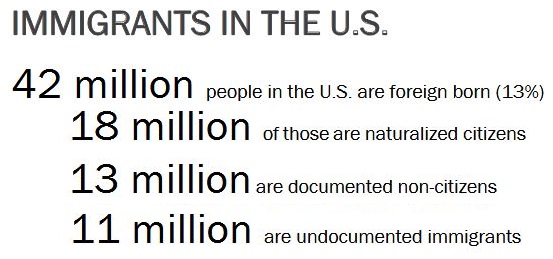
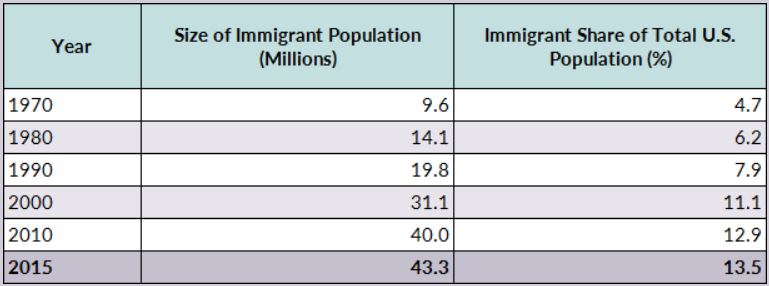
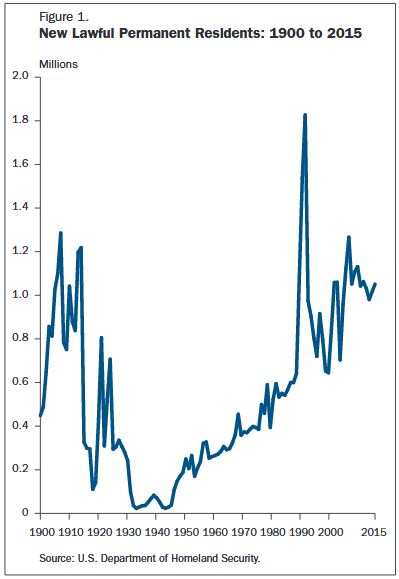
2. Legal immigrants living in the United States by country
of origin
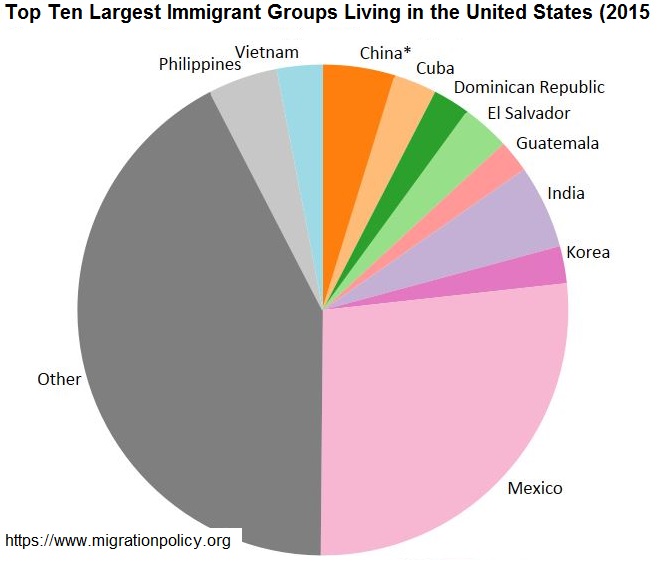
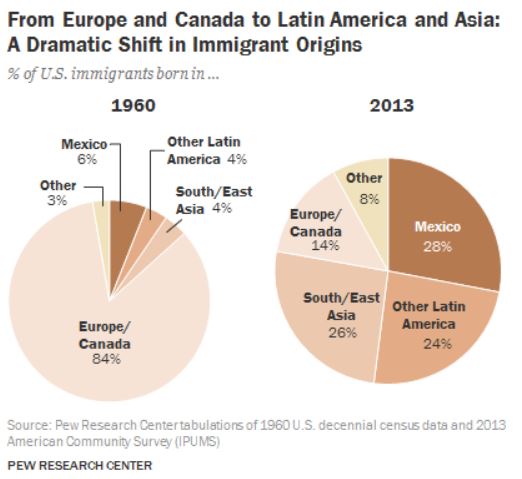
2. Annual Legal US Immigration (2015)
a. about 1 million new legal immigrants per year
enter the US (138 million in 2015)
b. numbers by category of admission (2015)
- family sponsored - about 891,000
- refugees - about 200,000
- employnment (skills) based - about 189,000
- diversity lottery - about 63,000
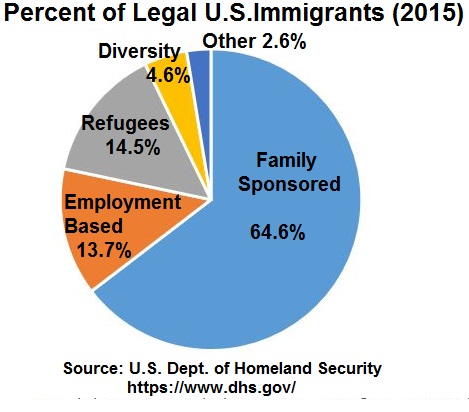
c. In 2015, 1.38 million foreign-born individuals moved
to the United States, a 2 percent increase from 1.36 million
in 2014.
1) India was the leading country of origin for
recent immigrants, with 179,800 arriving in 2015,
2) followed by 143,200 from China,
3) 139,400 from Mexico,
4) 47,500 from the Philippines, and
5) 46,800 from Canada.
d. In 2013, India and China overtook Mexico as the top
origin countries for recent arrivals.
B. Illegal Immigrants - About 11 million undocumented
immigrants are living in the United States

III. The Decision to Migrate
A. Pull Factors and Push Factors
B. Reasons
1. economic opportunities in destination country (pull
factor)
2. escape oppression (push factor)
3. family reunification (pull factor)
C. Marginal Benefits and Marginal Costs
1. earnings opportunities (MB): larger wage difference
= more likely to migrate
2. moving costs (MC):
a. higher moving costs = less likely to migrate
b. beaten paths: reduce moving costs = more likely to
migrate
3. Other
a. distance: greater distance = less likely to
migrate
b. age: younger workers = more likely to migrate
IV. The Economic Effects of Immigration
A. The fact that economic immigration to the United
States is sizeable and continuous affirms that in general the
economic benefits of immigration to the immigrants exceed their
costs.
B. . Personal Gain for those who Migrate
C. Impact on Wage Rates, Efficiency, and Output
1. Wage rates rise in source country and fall in
destination country
2. Efficiency gains from immigration: same number of workers
produces a greater total output
D. Brain drain
E. Complications and Modifications
1. Costs of migration
2. Remittances and backflows
2. Complementary vs. substitute resources
4. Expansion of capital in destination country
5. Full employment vs. unemployment
F. Fiscal Impacts: What effects do immigrants have on tax
revenues and government spending in the United States?
G. Research Findings:
1. All economists agree that U.S. immigration
increases U.S. domestic output and income and that highly
educated immigrants and successful entrepreneurs add to the
vitality of American enterprise.
2. But in light of the complications just discussed, no
single generalization is possible as to the impact of
immigration on the wages of native-born U.S. workers.
3. The best evidence indicates that immigration reduces the
wages of native-born workers who have low educations, and also
may reduce the salaries of some highly trained native-born
workers.
4. The overall effect of immigration on the average American
wage is much less clear. Scholarly estimates on that effect
range from minus 3 percent to plus 2 percent.
V. Immigration Policy
A. Current US immigration policy
1. favors family reunification (about two-thirds of
all legal immigrants)
2. refugees (about 14% of all legal immigrants)
3. employment-based - needed skills (about 13% of all legal
immigrants)
4. immigration diversity lottery (about 50,000 or less than
5% of all legal immigrants)
B."Three Ways To Totally Transform U.S. Immigration Policy"
NPR, Planet Money http://www.npr.org/blogs/money/2013/02/21/172501563/three-ways-to-totally-transform-u-s-immigration-policy
1. The Best And The Brightest: allow in mostly
skilled immigrants
2. The Highest Bidder: Let the markets decided who
can immigrate by auctioning the visas off to employers.
3. Let 'Em In: allow free immigration of anyone who
wants to enter the United States, except if there are security
or safety concerns. Similar to what happened in the U.S. from
1790 to 1882 and similar to migration between the 50 united
states and between the 28 countries of the European Union.
C. President Trump
1. improve border security - "build a wall"
2. reduce the total number of immigrants
3. emphasize "the best and the brightest'; Trump supports a
skills-based immigration policy (like Canada's current
policy)
4. fewer family reunification immigrants; reduce or abolish
"chain migration"
5. abolish the immigration diversity lottery
VI. The Illegal Immigration Debate
A. Employment Effects
1. PRO-immigration: Illegal immigrants take jobs that
Americans do not want
2. ANTI-immigration: Illegal immigrants take jobs from
Americans
3. Evidence: illegal immigration causes some substitution of
illegal workers for domestic workers, but the amount of
displacement is less than the total employment of the illegal
workers. Illegal immigration-as with legal
immigration-increases total employment in the United States
B. Wage Effects
1. the overall effect of illegal immigration on the
average wage rate in the economy is either a smaller decline or
even positive
2. Illegal immigration has very little effect on the average
level of wages in the United States. That average wage level
depends mainly on the nation's overall level of labor
productivity, which illegal immigration does not appreciably
affect.
C. Price Effects
1.In industries where illegal immigrants are heavily
used-for example, construction, agriculture, landscaping, home
cleaning, restaurant meals, and lodging-the presence of illegal
workers may have a discernable downward price effect.
2. Lower prices raise the standard of living of all
Americans and their families.
D. Fiscal Impacts on State and Local Governments: One major and
very legitimate concern about illegal immigration is the
negative fiscal impact it has on local and state
governments.
E. Other Concerns
1. undermines general respect for the law
2. unfair to the thousands of people enduring the expense
and long waits associated with the process for legally gaining
the right to live and work in the United States.
3. some observers see national defense as the greatest
long-term risk from porous borders
VII. Optimal Immigration
A. From a strictly economic perspective, immigration
should be expanded until its marginal benefit equals its marginal
cost.
B. The MB = MC conceptual framework explicitly recognizes that
there can be too few immigrants, just as there can be too
many.
VIII. Model: A Simple Immigration Model
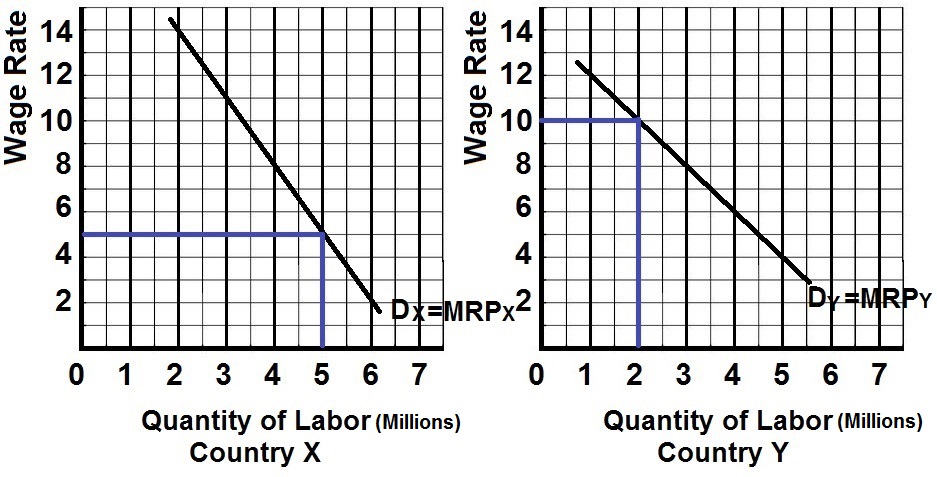
A. Assumptions:
1. DX is the demand for labor
in country X; DY is the demand for labor
in country Y.
2. before-migration labor forces of country X and country Y
are 5 and 2, respectively;
3. that neither country is experiencing substantial
long-term unemployment;
4. and that labor quality in the two countries is the
same.
5. migration (1) has no cost, (2) occurs solely in response
to wage differentials, and (3) is unimpeded by law in both
countries,
B. Conclusions:
1. workers will migrate from low-wage country X to the
high wage country Y until wage rates in the two countries are
equal at $8.
2. At that level, 1 million workers will have migrated from
country X to the country Y.
3. Country Y
a. the country Y wage level will fall from $10 to
$8,
b. country Y domestic output (the sum of the marginal
revenue products of the entire workforce) will increase. The
gain in domestic output in country Y is blue area on the
graph below.
4. Country Y
a. country X, the wage rate will rise from $8 to
$10,
b. country X domestic output will decline. The loss in
domestic output is red area on the graph below..
7. Observe that the gain in domestic output in country Y
(blue area) exceeds the loss of domestic output in country X
(red area). The migration from country X to country Y has
clearly increased the world's output and income.
8. Migration enables the world to produce a larger output
with its currently available resources. So labor mobility joins
international trade in enhancing the world's standard of
living.
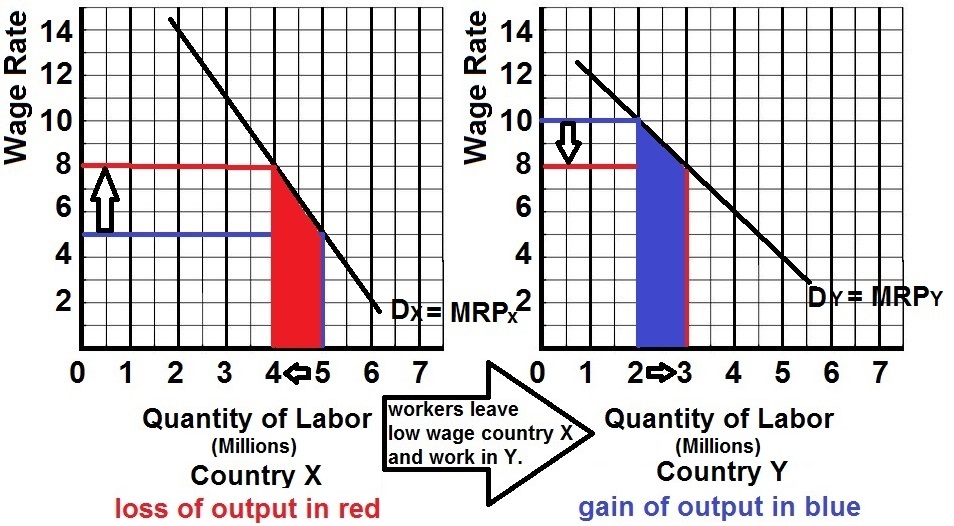
IX. Model: Impact of Illegal Workers in a Low Wage Labor
Market
A. Assumptions:
1. Employers in this market are willing and able to
ignore minimum wage laws
2. SD represents the supply of
domestically-born (and legal immigrant) workers;
3. With no immigration the wage = $10 and quantity employed
= 3 million
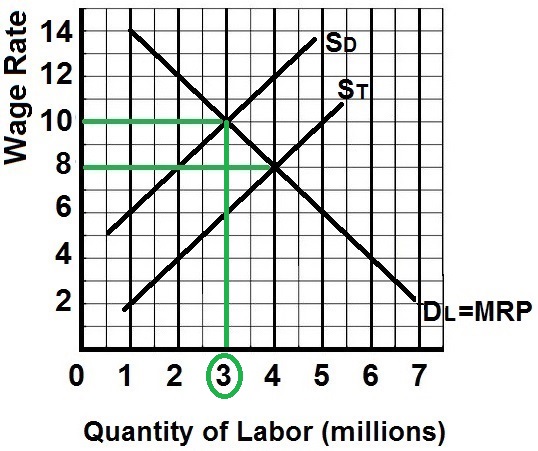
4. ST represents the total supply of
workers in this labor market (SD plus
illegal immigrants). Wages now is $8 and total employment is 4
million (2 million domestic employees and 2 million illegal
immigrants)
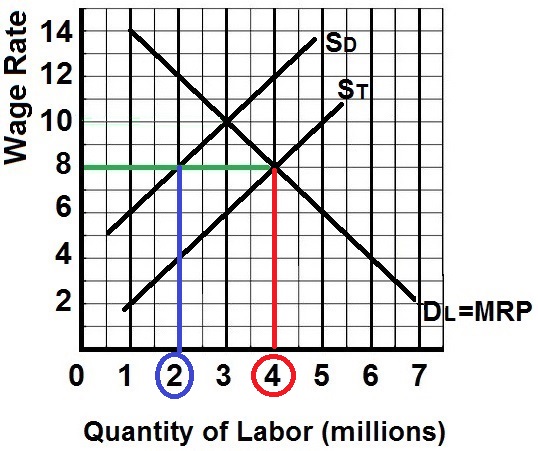
5. The horizontal distances between
ST and SD at the
various wage rates measure the number of illegal immigrants
offering their labor services at those wage rates (2
million)
6. Unless otherwise stated, illegal immigration is not
effectively blocked by the government.
B. Conclusions:
1. With illegal workers present, as implied by curve
ST, the equilibrium wage and level of
employment in this labor market are $8 and 4 million.
2. At the low wage of $8,
a. only 2 million domestic-born workers are willing
to work;
b. the other workers are 2 million illegal
immigrants.
3. Can we therefore conclude that illegal workers have
filled jobs that most U.S.-born workers do not want?
a. The answer is "yes," but only with the proviso:
"at wage rate $8."
b. if the United States cut off the full inflow of
illegal workers to this market, the relevant supply curve
would be SD and the wage rate would
rise to $10. Then 3 million domestic-born workers would
work.
4. Can we therefore conclude that illegal workers reduce the
employment of Americans by an amount equal to the employment of
illegal workers? No.
a. illegal immigration causes some substitution of
illegal workers for domestic workers,
b. but the amount of displacement is less than the total
employment of the illegal workers.
c. Illegal immigration, as with legal immigration,
increases total employment in the United States.
C. The Effects of Illegal Immigration - The Facts
1. Employment Effects:
a. Generally, illegal immigration causes some
substitution of illegal workers for domestic workers,
b. but the amount of displacement is less than the total
employment of the illegal workers.
c. Illegal immigration, as with legal immigration,
increases total employment in the United States.
2. Wage Effects:
a. Large flows of illegal workers into specific
low-wage labor markets reduce wage rates in those markets.
b. the overall effect of illegal immigration on the
average wage rate in the economy is either a smaller decline
or even positive.
1) As with legal immigrants, some illegal
workers are complementary inputs to domestic-born
workers, not substitutes, and therefore their presence
INCREASES employment of domestic workers
2) Only where illegal workers and legal workers are
substitute resources will the increase in labor supply
reduce the wages of other workers. Ironically, studies
show that the largest negative impact of illegal
immigrants is on the wages of previous immigrants, not on
native-born workers.
c. Illegal immigration has very little effect on the
average level of wages in the United States. That average
wage level depends mainly on the nation's overall level of
labor productivity, which illegal immigration does not
appreciably affect.
3. Price Effects: Because illegal immigrants work at lower
pay than would be necessary to attract native-born workers, the
prices of goods and services that illegal workers produce are
lower than they would be otherwise.
4. Fiscal Impacts on State and Local governments:
a. One major and very legitimate concern about
illegal immigration is the negative fiscal impact it has on
local and state governments. Cities and states with high
concentrations of illegal immigrants bear the main burden
b. Immigrants do, however, pay state sales taxes and
taxes on gasoline, and indirectly pay property taxes built
into rent.
5. Other Concerns:
a. allowing immigrants to enter the United States
unlawfully may undermine general respect for the law
b. illegal immigration is highly unfair to the thousands
of people enduring the expense and long waits associated
with the process for legally gaining the right to live and
work in the United States
c. some observers see national defense as the greatest
long-term risk from porous borders. The flow of illegal
entrants into the United States is clearly at odds with the
goal of homeland security. Ineffective border enforcement
against illegal immigrants allows career criminals and even
terrorists to enter the United States undetected.









